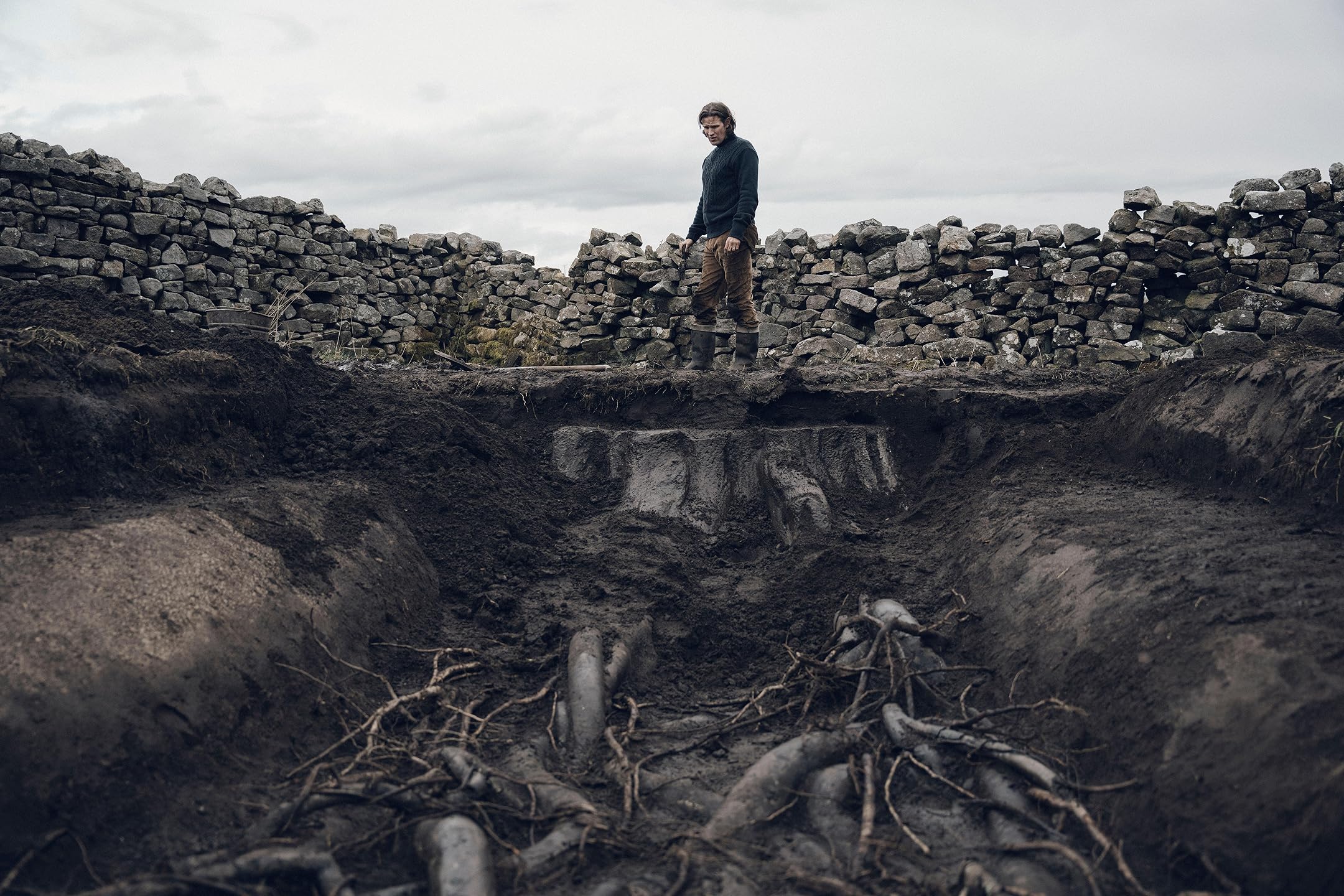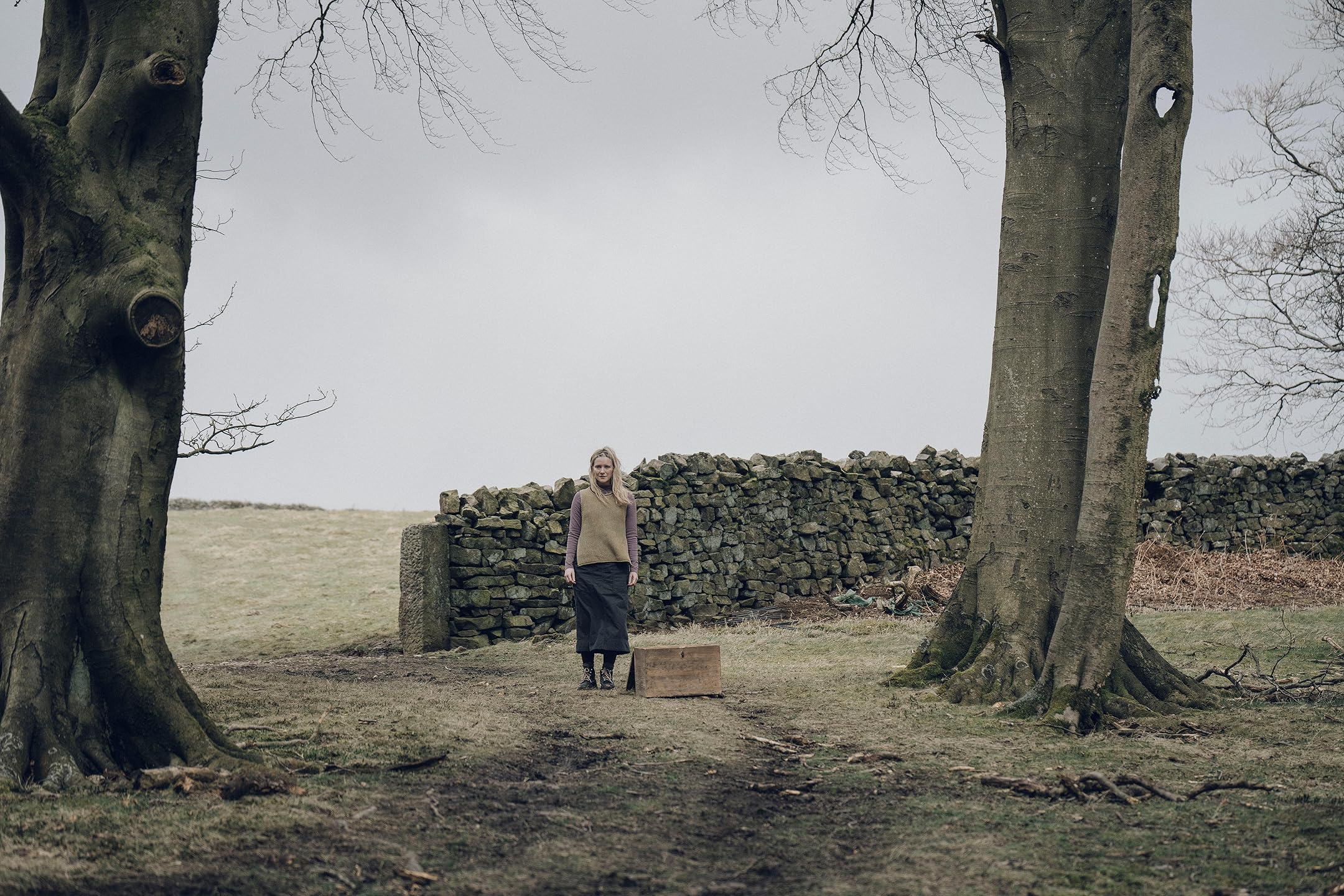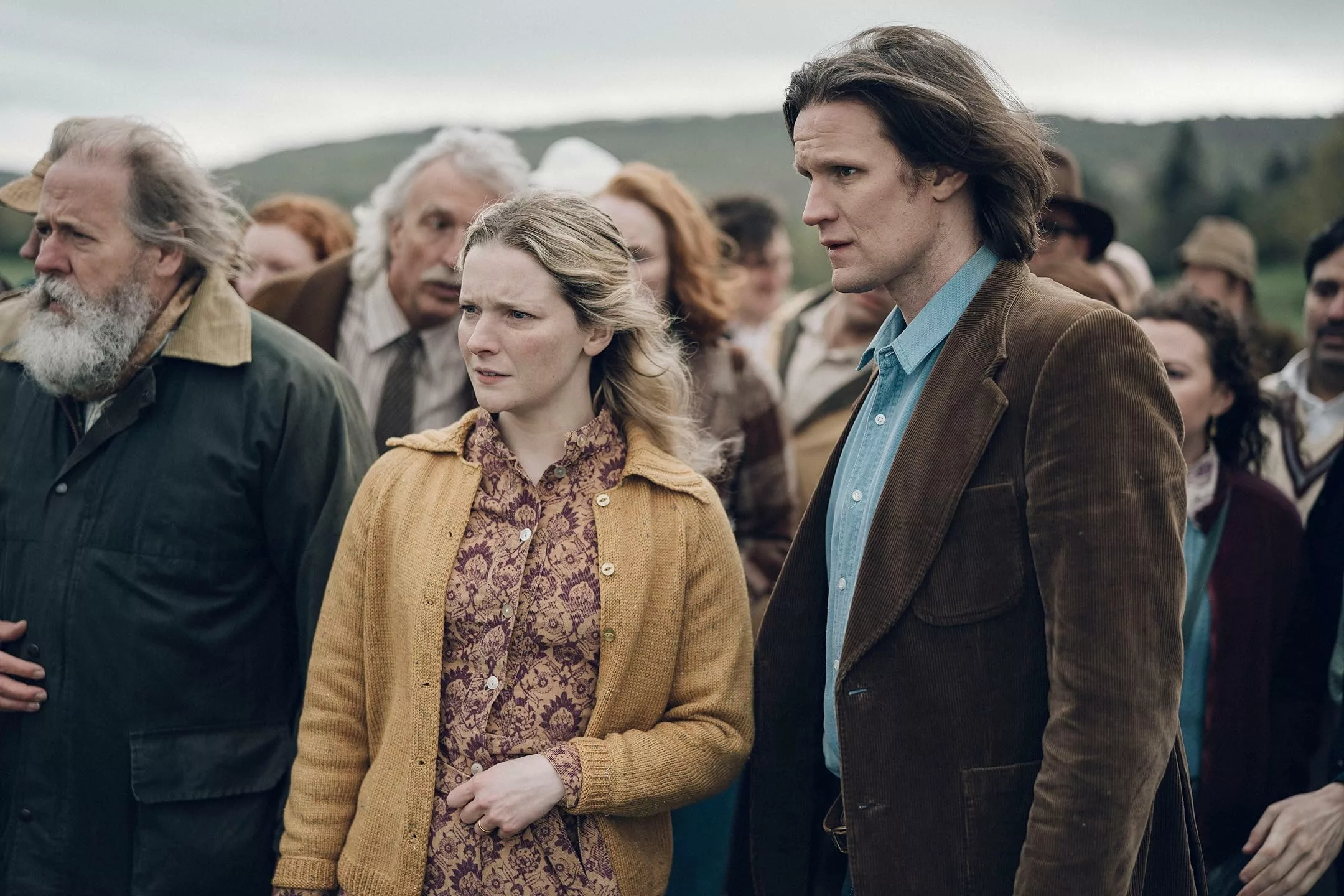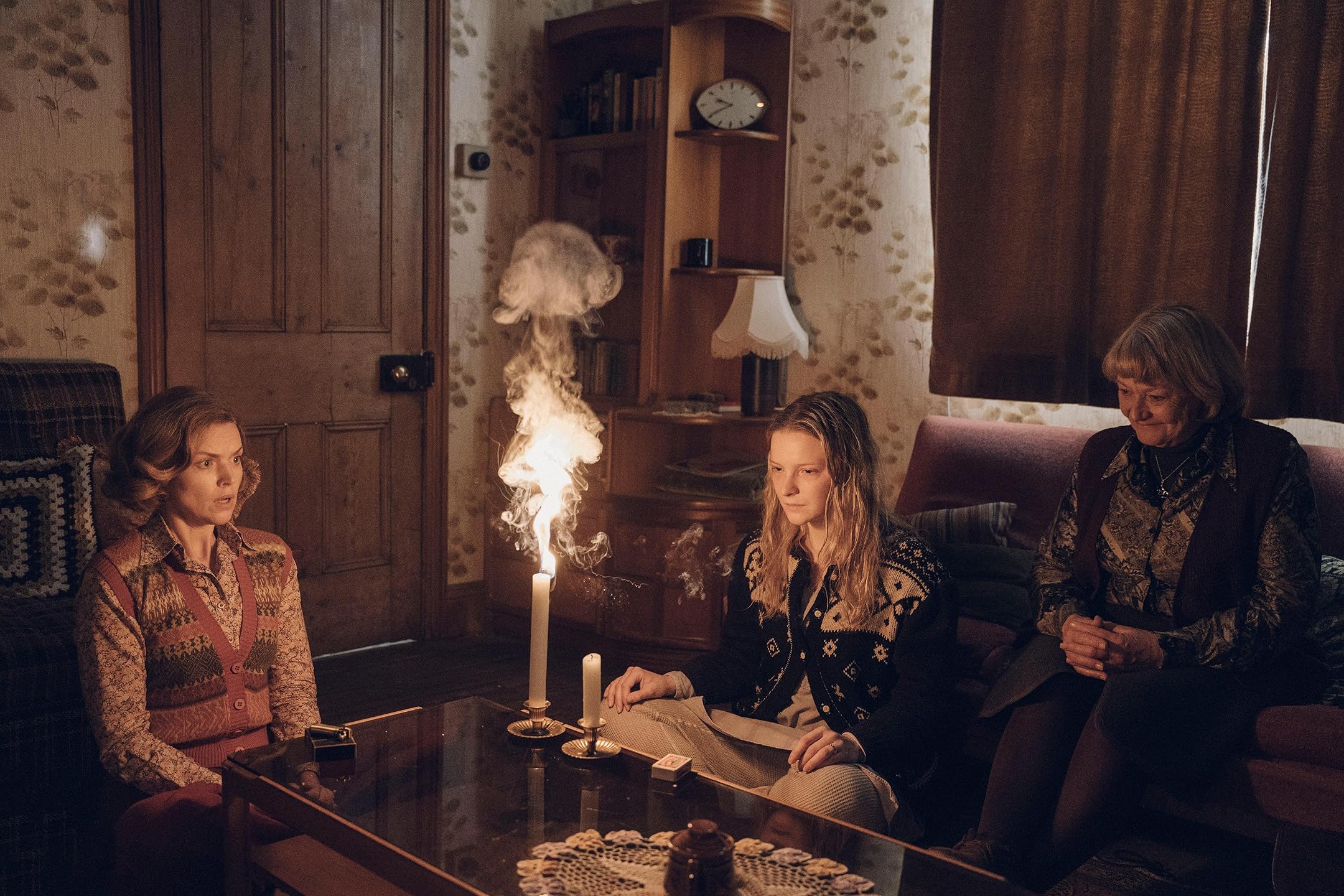Richard and Juliette are still grieving the loss of their young son Owen as they settle into their new home, the remote Yorkshire farmhouse called Starve Acre. Still reeling from the tragedy that led them to leave London, they hope the country air will allow Juliette time to heal.
But all is not as it seems at Starve Acre. Strange noises wake Owen in the night, and Richard discovers unsettling journals left by his father, who owned the farm years ago. The journals speak of dark folklore and beings that haunt the surrounding lands.
As Richard and Juliette grieve in separate ways, he throws himself into excavations on the farm, unearthing bones and relics that seem to exert a sinister power. She retreats inward, struggling with guilt and pain. Uncanny events escalate around them as Richard delves further into his father’s disturbing research.
Daniel Kokotajlo’s atmospheric direction immerses us in the era, from period costumes to the unsettled mood of the Yorkshire moors. Under its themes of loss and trauma, there lurk deeper mysteries that challenge what’s real—and push a broken family to the brink of madness.
Authentic Terrors of the 1970s British Countryside
Starve Acre feels so convincingly set in its 1970s backdrop thanks to the incredible attention to detail in its production elements. The moment you see Richard and Juliette’s outfits or the interior of Starve Acre farmhouse, you can practically smell the musty air.
Costume designer Emma Fryer nails the era’s rustic knits and layered looks, capturing the fashions of isolated country folk. Francesca Massariol’s set design populates the farm with authentic wallpaper, heavy wooden furniture, and other period touches that situate the drama in a bygone time.
Cinematographer Adam Scarth uses the weather itself as a character, shrouding outdoor shots in misty grime. His dim interiors emphasize cozy candles and firelight against the eternal gray skies outside. Together with Fryer and Massariol, he plunges us firmly into a rustic pre-digital world. The drab color palette amplifies the sensation of being marooned in an unforgiving natural environment. It’s a world without modern comforts, where the elements hold constant menace.
Scarth’s keen eye for composition intensifies unease in even ordinary settings. His oblique angles survey Starve Acre’s nooks and crannies as though something lurks out of view. Bleak vast landscapes composed as backdrops to the family’s isolation. Lighting mimics the seasons’ transition from dreary autumn into full winter darkness. Illumination feels sourced as much from the production design itself as any artificial means.
This authenticity is key to Starve Acre’s folk horror spell. It breathes chilly verisimilitude into the rising terrors, rooting supernatural threats in the tangible dread of our own history and habitat. Through these meticulous technical aspects, director Daniel Kokotajlo crafts one of the most believably unsettling periods in recent cinema.
Depth Amid the Dread
Starve Acre is bolstered tremendously by the raw emotional depth its leads, Matt Smith and Morfyd Clark, bring to their roles. As Richard and Juliette suffer the unthinkable loss of their son Owen, the couple’s grief consumes them in viscerally heartbreaking ways. Yet Smith and Clark never allow their characters to sink into melodrama.
Through subtle gestures and pained expressions, we see Richard and Juliette rigorously internalizing their agony. Clark especially fills Juliette with a vulnerability made all the more poignant by her fierce maternal instinct. Even as the story delves into realms of shock and surrealism, these actors anchor us with painfully human anchors.
Smith matching Clark’s intensely muted approach. As an academic, Richard internalizes his pain through obsessive work. But in Smith’s showing of frayed nerves and fleeting cracks in the stoic façade, we feel the turmoil shredding him from within. Their shared tragedy cracks open an emotional chasm between the spouses, yet in every haunted glance is a remnant of their enduring bond.
The supporting cast brings similar nuance to smaller roles that could have become stock. As Juliette’s sister Harriet, Erin Richards imbues concern for her sibling with sensible patience. Sean Gilder plays neighbor Gordon with a stalwart bluntness giving way to hints of his own darkness. And young Arthur Shaw affects a child’s innocent torment with heartbreaking ease.
Together, this ensemble ensures Starve Acre’s unease stems as much from its sensitive portrayal of private agonies as from any monstrous revelations. Even at their most unmoored from reality, Richard and Juliette remain tragically human. It’s a testament to these actors’ poignant work that, amid the pastoral terrors, we remain riveted most to the movie’s intimate wounds of the soul.
Below the Surface
Starve Acre plunges deeply into themes of grief and trauma and their intersection with ancient folk traditions. After their young son suddenly passes, Richard and Juliette each cope in their own way. Richard becomes obsessively immersed in excavating the farmland’s history, guided by his late father’s journals exploring local pagan myths. These excavations seem to mirror Richard’s inner excavations as he works through old wounds from his abusive upbringing.
Meanwhile, Juliette remains locked in the farmhouse, inconsolable in her sorrow. As Richard delves ever deeper, strange occurrences escalate around the property. Are these mere symptoms of the couple’s fractured mental states, or something more ominous and age-old stirring below the surface?
The film suggests the potential for both. Richard’s excavations unearth relics tied to folk legends, from the stumps of a once-mighty oak to a charmed horse’s bones that refuse to decay. His father’s writings make it clear some residents adhere to older spiritual traditions. As Richard and Juliette drift apart in their lonely orbits of anguish, it’s easy to feel the farm’s very soil shares in their psychic turbulence.
Kokotajlo keeps audience interpretation open. Perhaps the encroaching shadows merely reflect the miasma of the couple’s interior states. But perhaps darker mysteries truly haunt the aptly named Starve Acre, awakened by the confluence of past trauma resurfacing and present sorrow sinking in. Either way, a sense of timeless nature-spirits peering through cracks in our rationalism stays unsettlingly tangible.
The film so skillfully shows how private ruins can buckle our grasp on outward reality. In exploring grief’s depths, one may break through into unseen worlds below. Or find the unseen has burrowed much closer than we ever dreamed.
Pervasive Dread
Starve Acre is a masterclass in creating an unshakable atmosphere. It luxuriates in a mood of creepy unease that steadily permeates every scene. Director Daniel Kokotajlo stages the settings and sequences to steadily heighten a sense of lurking, nameless dread.
He’s aided enormously by technical aspects like Adam Scarth’s cinematography, which drenches shots in a muted yet visually striking color palette perfectly evoking the 1970s rural milieu. Perhaps most crucial is Matthew Herbert’s unnerving score. It employs delicate acoustic textures that entwine with the imagery, suddenly morphing into piercing shrieks that turn the blood cold.
Those more jarring musical moments don’t feel at odds with the grounded tone. Rather, they amplify tensions that have been intricately woven through even placid scenes until the breaking point. Kokotajlo exercises great control over pace, letting lengths of stillness accumulate power before releasing it in a shock.
The result is a movie that steadily consumes viewers in its permeating sense of wrongness, keeping them rapt despite some deliberately sluggish passages. Stylistically, it wears its 1970s British folk horror influences proudly, reminiscent of films like The Wicker Man in visuals and the unspoken intimations of dark ceremonies glimpsed in Don’t Look Now.
Kokotajlo’s unshowy direction never calls attention to itself, instead drawing watchers deep inside this shadowy world and reluctant to let go of its chilling spell. Even after, viewers may feel haunted by uncertain fears that the atmosphere has seeped under their skin too. It’s a remarkable achievement that justifies hype for this director’s innate skill at incubating bleak unease.
Disturbing Details
Several scenes in Starve Acre are genuinely unsettling, crafting atmosphere through unspoken intricacies. One moment sees Juliette dozing in front of an old TV, suddenly jolted awake by its harsh buzz of static. Another subtle scare comes across by suggestion alone: Richard discovers a hare skeleton taking on a disturbing new life.
Kokotajlo ratchets up tension through such innocent triggers. In the TV scene, the image fades to white noise just as Juliette drifts off. We share her disoriented panic on waking, left to imagine what may have caused it. Another scene sees Richard excavating and fixating on tiny clues, gradually realizing some supernatural force animates bones long left for dust.
A hare skeleton is staged and lit to seem disturbingly vigorous. Practical and digital effects blend so seamlessly, we can’t pinpoint the living from the lifeless. Details that could be dismissed individually coalesce into an unshakable wrongness. Such economical moments rely on understatement yet burrow deeply under the skin.
Subtle shocks and strange occurrences gradually insinuate Starve Acre’s menace. But effects work also impress in bolder sequences, like the hare rising into a hellish creature. Crafting its warped anatomy with fine artistry, effects heighten unease without resorting to gore.
From unplaceable sounds to evolving physical abnormalities, small disturbances implicate greater darkness. Though some scenes veer into surreal tangents, careful design anchors them in realness. Unseen terrors incubate within reality’s microscopic cracks until some nameless terror manifests in flesh.
Creepy Countryside Chills
Starve Acre firmly establishes itself as the rare breed of “old-school folk horror.” It plunges viewers into the damp Yorkshire moors of the 1970s, crafted with immaculate period detail in costumes, decor, and more. Within this setting, a haunting atmosphere takes root and blossoms into full-bloomed dread.
Kokotajlo cultivates this unease through his leads’ emotionally visceral performances as they grapple with grief and grasp for occult answers. Their unraveling mental states reflect the rural setting’s own plunge into otherworldly obscurity. Together, director and stars plunge the audience into ever-deepening disquiet.
Fans of classic chillers like Don’t Look Now and The Wicker Man will find much to appreciate. Starve Acre channels their nostalgic spooks through a modern lens. While some narrative strands stray into outlandish plots, Kokotajlo’s skilled hand keeps a tight rein on plausibility. This anchors even the story’s strangest beats in psychological realism.
With Starve Acre, Kohotajlo cements his place as a director capable of balancing dark subject matter with visual panache. He brings atmospheric intrigue to both gritty dramas and folk horror tales. This proves him equally talented with grounded realism and grounded supernatural chills. His evolving craft will satisfy both devoted cinephiles and genre buffs alike.
For those who relish a creepy countryside tale told with heart and hoots, Starve Acre awaits with its unsettling charms intact.
The Review
Starve Acre
Daniel Kokotajlo's Starve Acre proves to be an atmospheric and unsettling addition to the folk horror canon. Whilst some story elements drift into tangents, Kokotajlo maintains an unnerving tone through the unflinching leads' descent into grief and the setting's grim rural mystique. Matt Smith and Morfydd Clark anchor the unsettled psychological drama with nuanced vulnerability. Kokotajlo confirms his talent for blending realism with supernatural intrigue, subverting expectations against predictable tropes. For fans seeking an unsettling yet beautiful tale of grief and local legends, Starve Acre delivers haunting countryside chills.
PROS
- Atmospheric and unsettling folk horror tone
- Strong performances from Matt Smith and Morfydd Clark
- Grounded direction that prevents the story from becoming silly
- Evocative period setting of 1970s rural Yorkshire
- Blends psychological drama and supernatural mystery
CONS
- Narrative drifts into some tangential plot points
- Story conventions are somewhat predictable at times.
- Background of Juliette's character feels underdeveloped.






















































Discussion about this post